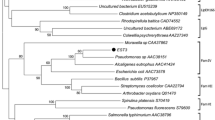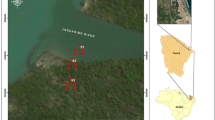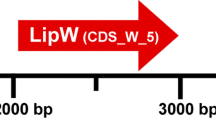Abstract
Two genes encoding lipolytic enzymes were isolated from a metagenomic library constructed from oil-polluted mud flats. An esterase gene, est3K, encoded a protein of 299 amino acids (ca. 32,364 Da). Est3K was a family IV esterase with typical motifs, HGGG, and HGF. Although est3K showed high identity to many genes with no information on their enzymatic properties, Est3K showed the highest identity (36 %) to SBLip5.1 from forest soil metagenome when compared to the enzymes with reported properties. A lipase gene, lip3K, encoded a protein of 616 amino acids (ca. 64,408 Da). Lip3K belonged to family I.3 lipase with a C-terminal secretion signal and showed the highest identity (93 %) to the lipase of Pseudomonas sp. MIS38. The presence of several newly identified conserved motifs in Est3K and Lip3K are suggested. Both Est3K and Lip3K exerted their maximal activity at pH 9.0 and 50 °C. The activity of Lip3K was significantly increased by the presence of 30 % methanol. The ability of the enzymes to retain activities in the presence of methanol and the substrates may offer a merit to the biotechnological applications of the enzymes such as transesterification. The activity and the thermostability of Lip3K were increased by Ca2+. Est3K and Lip3K preferred p-nitrophenyl butyrate (C4) and octanoate (C8), respectively, as the substrate and acted independently on the substrates with no synergistic effect.






Similar content being viewed by others
References
Ollis, D. L., Cheah, E., Cygler, M., Dijkstra, B., Frolow, F., Franken, S. M., et al. (1992). The alpha/beta hydrolase fold. Protein Engineering, 5, 197–211.
Jaeger, K. E., & Eggert, T. (2002). Lipases for biotechnology. Current Opinion in Biotechnology, 13, 390–397.
Arpigny, J. L., & Jaeger, K. E. (1999). Bacterial lipolytic enzymes: Classification and properties. Biochemical Journal, 343, 177–183.
Charbonneau, D. M., & Beauregard, M. (2013). Role of key salt bridges in thermostability of G. thermodenitrificans EstGtA2: Distinctive patterns within the new bacterial lipolytic enzyme family XV. PLoS One, 8, e76675.
Baltrus, D. A., Nishimura, M. T., Romanchuk, A., Chang, J. H., Mukhtar, M. S., Cherkis, K., et al. (2011). Dynamic evolution of pathogenicity revealed by sequencing and comparative genomics of 19 Pseudomonas syringae isolates. PLoS Pathogens, 7, e1002132.
Dudnik, A., & Dudler, R. (2013). Non contiguous-finished genome sequence of Pseudomonas syringae pathovar syringae strain B64 isolated from wheat. Standards Genomic Sciences, 8, 420–429.
Nacke, H., Will, C., Herzog, S., Nowka, B., Engelhaupt, M., & Daniel, R. (2011). Identification of novel lipolytic genes and gene families by screening of metagenomic libraries derived from soil samples of the German Biodiversity Exploratories. FEMS Microbiology Ecology, 78, 188–201.
Rodríguez-Palenzuela, P., Matas, I. M., Murillo, J., López-Solanilla, E., Bardaji, L., Pérez-Martínez, I., et al. (2010). Annotation and overview of the Pseudomonas savastanoi pv. savastanoi NCPPB 3335 draft genome reveals the virulence gene complement of a tumour-inducing pathogen of woody hosts. Environmental Microbiology, 12, 1604–1620.
Bassegoda, A., Fillat, A., Pastor, F. I., & Diaz, P. (2013). Special Rhodococcus sp. CR-53 esterase Est4 contains a GGG(A)X-oxyanion hole conferring activity for the kinetic resolution of tertiary alcohols. Applied Microbiology and Biotechnology, 97, 8559–8568.
Biver, S., & Vandenbol, M. (2013). Characterization of three new carboxylic ester hydrolases isolated by functional screening of a forest soil metagenomic library. Journal of Industrial Microbiology and Biotechnology, 40, 191–200.
López, G., Chow, J., Bongen, P., Lauinger, B., Pietruszka, J., Streit, W. R., & Baena, S. (2014). A novel thermoalkalostable esterase from Acidicaldus sp. strain USBA-GBX-499 with enantioselectivity isolated from an acidic hot springs of Colombian Andes. Applied Microbiology and Biotechnology, 98, 8603–8616.
Handelsman, J. (2004). Metagenomics application of genomics to uncultured microorganisms. Microbiology and Molecular Biology Reviews, 68, 669–685.
Fang, Z., Li, J., Wang, Q., Fang, W., Peng, H., Zhang, X., & Xiao, Y. (2014). A novel esterase from a marine metagenomic library exhibiting salt tolerance ability. Journal of Microbiology and Biotechnology, 24, 771–780.
Chow, J., Kovacic, F., Dall Antonia, Y., Krauss, U., Fersini, F., Schmeisser, C., et al. (2012). The metagenome-derived enzymes LipS and LipT increase the diversity of known lipases. PLoS One, 7, e47665.
Bunterngsook, B., Kanokratana, P., Thongaram, T., Tanapongpipat, S., Uengwetwanit, T., Rachdawong, S., et al. (2010). Identification and characterization of lipolytic enzymes from a peat-swamp forest soil metagenome. Bioscience, Biotechnology, and Biochemistry, 74, 1848–1854.
Kim, Y. H., Kwon, E. J., Kim, S. K., Jeong, Y. S., Kim, J., Yun, H. D., & Kim, H. (2010). Molecular cloning and characterization of a novel family VIII alkaline esterase from a compost metagenomic library. Biochemical and Biophysical Research Communications, 393, 45–49.
Bendsten, J. D., Nielsen, H., von Heijne, G., & Brunak, S. (2004). Improved prediction of signal peptide: SignalP 3.0. Journal of Molecular Biology, 340, 783–795.
Finn, R. D., Tate, J., Mistry, J., Coggill, P. C., Sammut, S. J., Hotz, H. R., et al. (2008). The Pfam protein families database. Nucleic Acids Research Database Issue, 36, D281–D288.
Jeong, Y. S., Na, H. B., Kim, S. K., Kim, Y. H., Kwon, E. J., Kim, J., et al. (2012). Characterization of xyn10J, a novel family 10 xylanase from a compost metagenomic library. Applied Biochemistry and Biotechnology, 166, 1328–1339.
Lee, K. Y., Kim, J. H., & Kim, H. (1996). Isolation and characterization of Bacillus sp. KD1014 producing carboxymethyl-cellulase. Journal of Microbiology, 34, 305–310.
Lowry, O. H., Rosenbrough, N. J., Farr, A. L., & Randall, R. J. (1951). Protein measurement with the folin phenol reagent. Journal of Biological Chemistry, 193, 265–275.
Laemmli, U. K. (1970). Cleavage of structural proteins during the assembly of the head of bacteriophage T4. Nature, 227, 680–685.
Choo, D. W., Kurihara, T., Suzuki, T., Soda, K., & Esaki, N. (1998). A cold-adapted lipase of an Alaskan psychrotroph, Pseudomonas sp. strain B11–1: Gene cloning and enzyme purification and characterization. Applied and Environment Microbiology, 64, 486–491.
Hong, K. S., Lim, H. K., Chung, E. J., Park, E. J., Lee, M. H., Kim, J. C., et al. (2007). Selection and characterization of forest soil metagenome genes encoding lipolytic enzymes. Journal of Microbiology and Biotechnology, 17, 1655–1660.
Virk, A. P., Sharma, P., & Capalash, N. (2011). A new esterase, belonging to hormone-sensitive lipase family, cloned from Rheinheimera sp. isolated from industrial effluent. Journal of Microbiology and Biotechnology, 21, 667–674.
Amada, K., Haruki, M., Imanaka, T., Morikawa, M., & Kanaya, S. (2000). Overproduction in Escherichia coli, purification and characterization of a family I.3 lipase from Pseudomonas sp. MIS38. Biochimica et Biophysica Acta, 1478, 201–210.
Jiang, Z., Zheng, Y., Luo, Y., Wang, G., Wang, H., Ma, Y., & Wei, D. (2005). Cloning and expression of a novel lipase gene from Pseudomonas fluorescens B52. Molecular Biotechnology, 31, 95–101.
Panizza, P., Syfantou, N., Pastor, F. I., Rodríguez, S., & Díaz, P. (2013). Acidic lipase Lip I.3 from a Pseudomonas fluorescens-like strain displays unusual properties and shows activity on secondary alcohols. Journal of Applied Microbiology, 114, 722–732.
Johnson, L. A., Beacham, I. R., MacRae, I. C., & Free, M. L. (1992). Degradation of triglycerides by a pseudomonad isolated from milk: Molecular analysis of a lipase-encoding gene and its expression in Escherichia coli. Applied and Environment Microbiology, 58, 1776–1779.
Luo, Y., Zheng, Y., Jiang, Z., Ma, Y., & Wei, D. (2006). A novel psychrophilic lipase from Pseudomonas fluorescens with unique property in chiral resolution and biodiesel production via transesterification. Applied Microbiology and Biotechnology, 73, 349–355.
Tan, Y., & Miller, K. J. (1992). Cloning, expression, and nucleotide sequence of a lipase gene from Pseudomonas fluorescens B52. Applied and Environment Microbiology, 58, 1402–1407.
Angkawidjaja, C., & Kanaya, S. (2006). Family I.3 lipase: Bacterial lipases secreted by the type 1 secretion system. Cellular and Molecular Life Sciences, 63, 2804–2817.
Kuwahara, K., Angkawidjaja, C., Koga, Y., Takano, K., & Kanaya, S. (2011). Importance of an extreme C-terminal motif of a family I.3 lipase for stability. Protein Engineering, Design & Selection, 24, 411–418.
Yao, H., Yu, S., Zhang, L., Zuo, K., Ling, H., Zhang, F., & Tang, K. (2008). Isolation of a novel lipase gene from Serratia liquefaciens S33 DB-1, functional expression in Pichia pastoris and its properties. Molecular Biotechnology, 38, 99–107.
Kuwahara, K., Angkawidjaja, C., Matsumura, H., Koga, Y., Takano, K., & Kanaya, S. (2008). Importance of the Ca2+-binding sites in the N-catalytic domain of a family I.3 lipase for activity and stability. Protein Engineering, Design & Selection, 21, 737–744.
Kojima, Y., Kobayashi, M., & Shimizu, S. (2003). A novel lipase from Pseudomonas fluorescens HU380: Gene cloning, overproduction, renaturation-activation, two-step purification, and characterization. Journal of Bioscience and Bioengineering, 96, 242–249.
Beven, C. A., Dieckelmann, M., & Beacham, I. R. (2001). A strain of Pseudomonas fluorescens with two lipase-encoding genes, one of which possibly encodes cytoplasmic lipolytic activity. Journal of Applied Microbiology, 90, 979–987.
Zhang, J. W., & Zeng, R. Y. (2008). Molecular cloning and expression of a cold-adapted lipase gene from an Antarctic deep sea psychrotrophic bacterium Pseudomonas sp. 7323. Marine Biotechnology, 10, 612–621.
Yang, J., Zhang, B., & Yan, Y. (2008). Cloning and expression of Pseudomonas fluorescens 26–2 lipase gene in Pichia pastoris and characterizing for transesterification. Applied Biochemistry and Biotechnology, 159, 355–365.
Sulong, M. R., Abdul Rahman, R. N., Salleh, A. B., & Basri, M. (2006). A novel organic solvent tolerant lipase from Bacillus sphaericus 205y: Extracellular expression of a novel OST-lipase gene. Protein Expression and Purification, 49, 190–195.
Santambrogio, C., Sasso, F., Natalello, A., Brocca, S., Grandori, R., Doglia, S. M., & Lotti, M. (2013). Effects of methanol on a methanol-tolerant bacterial lipase. Applied Microbiology and Biotechnology, 97, 8609–8618.
Acknowledgments
This study was supported by the Ministry of Environment of the Republic of Korea Grant No. 2008-05001-0033-0) and partially by the Suncheon Research Center for Natural Medicines, Republic of Korea.
Author information
Authors and Affiliations
Corresponding author
Rights and permissions
About this article
Cite this article
Kim, H.J., Jeong, Y.S., Jung, W.K. et al. Characterization of Novel Family IV Esterase and Family I.3 Lipase from an Oil-Polluted Mud Flat Metagenome. Mol Biotechnol 57, 781–792 (2015). https://doi.org/10.1007/s12033-015-9871-4
Published:
Issue Date:
DOI: https://doi.org/10.1007/s12033-015-9871-4




